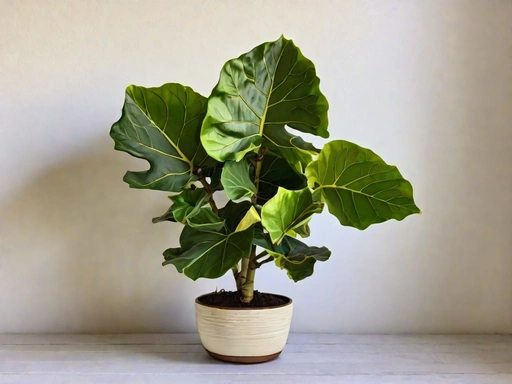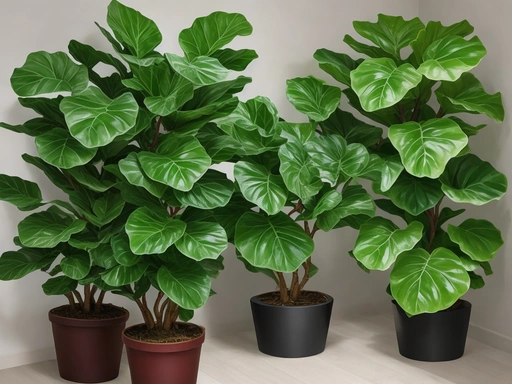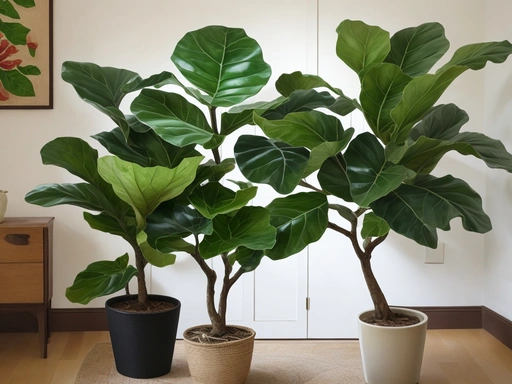How To Revive a Struggling Indoor Fiddle-Leaf Fig – The Ultimate Guide!
Key Takeaways:
- Bright, indirect sunlight is crucial for a struggling indoor Fiddle-leaf fig.
- Proper watering is essential to revive a struggling indoor Fiddle-leaf fig.
- Regularly cleaning the leaves of a struggling indoor Fiddle-leaf fig can help improve its health.
- Fertilizing with a balanced houseplant fertilizer can aid in reviving a struggling indoor Fiddle-leaf fig.
Is your indoor Fiddle-leaf fig looking a little worse for wear? Don’t panic! I’ve got some expert tips and tricks to bring your beloved plant back to life.
In this article, we’ll dive deep into understanding the struggles of indoor Fiddle-leaf figs, identifying the signs of a struggling plant, and exploring the common reasons behind their low spirits.
But fear not, I’ll also guide you through the process of assessing your plant’s needs, rescuing it from the brink, and preventing future struggles. So grab your green thumbs and let’s revive your struggling indoor Fiddle-leaf fig together!
| Step | Description |
| 1 | Assess the plant’s needs by checking for common issues such as yellowing leaves, brown spots, or poor growth. |
| 2 | Check the watering routine and adjust it if necessary. Fiddle-leaf figs prefer well-drained soil and require watering when the top inch of soil feels dry. |
| 3 | Ensure the plant receives adequate sunlight. Place it near a bright window, but avoid direct sunlight as it can scorch the leaves. |
| 4 | Improve the humidity levels by misting the leaves regularly or placing a tray of water near the plant. |
| 5 | Consider repotting the plant if it’s root-bound or if the soil is compacted, using a well-draining potting mix. |
| 6 | Prune any brown or yellowing leaves, as well as leggy growth, to encourage healthier growth. |
| 7 | Fertilize the plant with a balanced liquid fertilizer every 2-4 weeks during the growing season. |
| 8 | Monitor the plant closely and adjust care practices as needed to address any ongoing issues. |
Understanding the struggles of your indoor Fiddle-leaf fig
Is your indoor Fiddle-leaf fig struggling? Let’s dive into the signs and common reasons behind their struggles.
Signs that your indoor Fiddle-leaf fig is struggling
If your indoor Fiddle-leaf fig is struggling, there are several signs to look out for.
These include yellowing or browning leaves, dropping leaves, wilting or drooping foliage, and stunted growth.
Additionally, if you notice pests such as spider mites or scale insects on your plant, it could be a sign of distress.
Observing these signs will help you address the issues your Fiddle-leaf fig is facing and take the necessary steps to revive it.

Common reasons why indoor Fiddle-leaf figs struggle
Indoor Fiddle-leaf figs can struggle due to various reasons, such as inadequate light, overwatering or underwatering, low humidity levels, and improper soil.
These factors can lead to yellowing or dropping leaves, stunted growth, and overall decline in the plant’s health.
It’s important to assess and address these issues to revive your struggling Fiddle-leaf fig.
Assessing the needs of your indoor Fiddle-leaf fig
To successfully assess the needs of your indoor Fiddle-leaf fig, you should consider its light requirements, watering techniques, humidity levels, and choice of soil.
Identifying the right amount of light for your indoor Fiddle-leaf fig
The right amount of light for your indoor Fiddle-leaf fig is bright, indirect light. Place your plant near a window where it can receive bright, filtered sunlight.
Avoid exposing it to direct sunlight as it can scorch the leaves.
A good rule of thumb is to provide your Fiddle-leaf fig with 4-6 hours of bright, indirect light per day. If the leaves start to droop or lose their vibrant green color, it may be a sign that the plant is not getting enough light.
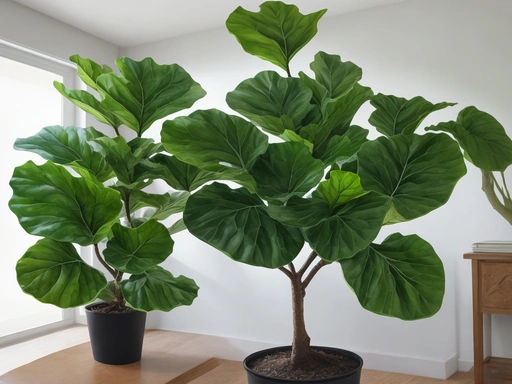
Proper watering techniques for a struggling indoor Fiddle-leaf fig
To properly water a struggling indoor Fiddle-leaf fig, you should follow these guidelines:
- Check the soil: Before watering, make sure to check the moisture level of the soil. Stick your finger about an inch into the soil. If it feels dry, it’s time to water. If it’s still moist, wait a bit longer.
- Water thoroughly: When watering, ensure that you thoroughly saturate the soil until water drains out from the drainage holes at the bottom of the pot. This helps to flush out any accumulated salts or toxins in the soil.
- Don’t overwater: Fiddle-leaf figs prefer slightly dry conditions, so overwatering can lead to root rot. Allow the top layer of soil to dry out between waterings.
- Maintain consistency: Establish a watering routine that is consistent and follow it. Fiddle-leaf figs prefer regular watering rather than sporadic watering. However, adjust the frequency based on the specific needs of your plant and the conditions in your home.
- Use room temperature water: Make sure to use room temperature water when watering your indoor Fiddle-leaf fig. Cold water can shock the roots and hot water can scorch them.

Checking the humidity levels for your indoor Fiddle-leaf fig
Checking the humidity levels for your indoor Fiddle-leaf fig is important for its well-being.
You can do this by using a hygrometer to measure the humidity in the air around your plant.
Aim for a humidity level between 30% and 65% for optimal growth.
If the humidity is too low, consider using a humidifier or placing a water tray near the plant.
If it’s too high, increase air circulation or use a dehumidifier.
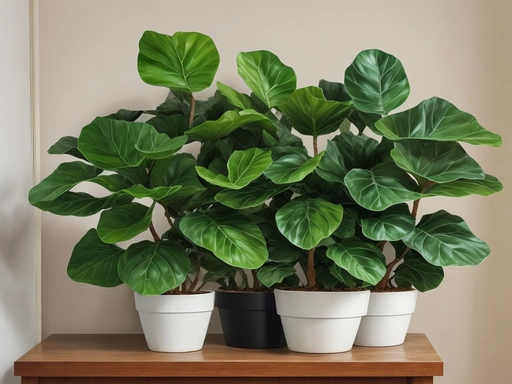
Choosing the right soil for your indoor Fiddle-leaf fig
Choosing the right soil for your indoor Fiddle-leaf fig is essential for its health and growth. Opt for a well-draining soil mix that retains moisture without becoming waterlogged.
A mixture of peat moss, perlite, and sand works well.
Avoid using heavy, compact soils or ones with high levels of clay.
Rescuing a struggling indoor Fiddle-leaf fig
Has your indoor Fiddle-leaf fig seen better days?
Here’s how to revive it!
Trimming and pruning techniques to rejuvenate your indoor Fiddle-leaf fig
To rejuvenate your indoor Fiddle-leaf fig, you can trim and prune it.
Here are a few techniques:
- Prune dead or yellowing leaves: Start by removing any leaves that are brown or yellow. This will help redirect the plant’s energy towards healthy growth.
- Trim leggy branches: If your fig plant has long, leggy branches, you can trim them back. Cut above a leaf node, which is where a new leaf grows from the branch.
- Shape the plant: If your Fiddle-leaf fig has a desired shape in mind, trim back any branches that are growing out of bounds. This will help maintain its desired shape.
- Pinch off new growth: If your fig plant is producing new growth that is becoming too tall or lanky, you can pinch off the tip to encourage bushier growth.
Remember, it’s important to use clean, sharp pruning shears to avoid damaging the plant.
Additionally, avoid pruning more than one-third of the plant’s foliage at a time to prevent stress.
Supporting and staking methods for a weak indoor Fiddle-leaf fig
To support and stake a weak indoor Fiddle-leaf fig, you can follow these steps:
- Choose a sturdy stake: Pick a stake that is strong enough to support the weight of your fig tree. Bamboo or wooden stakes are commonly used.
- Position the stake: Place the stake near the base of the plant, ensuring it is driven securely into the soil without damaging the roots.
- Attach the plant to the stake: Gently tie the stem or trunk of your fig tree to the stake using soft plant ties or twine. Make sure the tie is snug but not too tight to allow for growth.
- Check and adjust regularly: Monitor your fig tree to ensure it is growing upright. If you notice any leaning or additional instability, readjust the ties or provide additional support as needed.
Remember, providing proper support and staking for your weak indoor Fiddle-leaf fig will help it regain its strength and maintain an upright growth.
Fertilizing guidelines to promote growth in a struggling indoor Fiddle-leaf fig
To promote growth in a struggling indoor Fiddle-leaf fig, fertilizing is key.
Use a balanced, water-soluble fertilizer with a ratio of 3:1:2 (nitrogen, phosphorus, potassium).
Apply it every four to six weeks during the growing season.
Ensure the soil is moist before fertilizing, and dilute the fertilizer according to package instructions.
Avoid over-fertilizing, as it can burn the roots.
Repotting strategies for a struggling indoor Fiddle-leaf fig
When repotting a struggling indoor Fiddle-leaf fig, follow these strategies:
- Choose a larger pot that allows for growth.
- Gently remove the plant from its current pot, being careful not to damage the roots.
- Inspect the roots for any signs of decay or rot; trim away any damaged roots.
- Use a well-draining potting soil mixture specifically designed for Fiddle-leaf figs.
- Place the plant in the new pot, making sure it sits at the same depth as before.
- Fill in the gaps with fresh soil, gently tamping it down.
- Water the plant thoroughly and place it in a location with bright, indirect light to promote recovery.
Preventing future struggles of your indoor Fiddle-leaf fig
To prevent future struggles for your indoor Fiddle-leaf fig, focus on maintaining proper lighting, establishing a consistent watering routine, creating a suitable humidity environment, and providing the right nutrients and fertilizers.
Maintaining proper lighting conditions for your indoor Fiddle-leaf fig
To maintain proper lighting conditions for your indoor Fiddle-leaf fig, place it in a spot with bright, indirect sunlight. Avoid placing it in direct sunlight as it can scorch the leaves.
You can rotate the plant occasionally to ensure all sides receive adequate light.
If the light is insufficient, consider using artificial grow lights to supplement the natural light.
Establishing a consistent watering routine for your indoor Fiddle-leaf fig
To establish a consistent watering routine for your indoor Fiddle-leaf fig, it’s important to strike a balance. Water your plant thoroughly, allowing the water to run out from the drainage holes.
Then, wait until the top inch of soil is dry before watering again.
Avoid overwatering or letting the soil completely dry out. Find the right frequency based on your home’s environment and the plant’s needs.
Creating a suitable humidity environment for your indoor Fiddle-leaf fig
To create a suitable humidity environment for your indoor Fiddle-leaf fig, there are a few things you can do. Firstly, mist the leaves regularly to increase humidity.
Secondly, consider placing a tray of water near the plant to add moisture to the air.
Thirdly, avoid placing your fig near drafts or heating vents, as these can dry out the air. By taking these steps, you can help provide the right humidity level for your indoor Fiddle-leaf fig.
Providing the right nutrients and fertilizers for your indoor Fiddle-leaf fig
To provide the right nutrients and fertilizers for your indoor Fiddle-leaf fig, use a balanced houseplant fertilizer with a ratio of 3:1:2 or 2:1:1 (nitrogen, phosphorus, potassium). Apply it every 2-4 weeks during the growing season.
Dilute the fertilizer according to the package instructions and avoid over-fertilizing, as it can damage the plant.
Additionally, consider using a well-draining soil mix to ensure proper nutrient uptake.
Frequently Asked Questions
How often should I water my struggling indoor Fiddle-leaf fig?
For a struggling indoor Fiddle-leaf fig, it’s important to find the right balance when it comes to watering. Instead of following a strict watering schedule, check the moisture level of the soil regularly.
Stick your finger about an inch deep into the soil – if it feels dry, it’s time to water.
Overwatering can lead to root rot, so make sure to let the top inch of soil dry out between waterings. Remember, it’s better to underwater than to overwater your fiddle-leaf fig.
Should I trim the leaves of my struggling indoor Fiddle-leaf fig?
Should I trim the leaves of my struggling indoor Fiddle-leaf fig? Yes, trimming the leaves of your struggling indoor Fiddle-leaf fig can actually help rejuvenate it.
By removing any damaged or diseased leaves, you allow the plant to redirect its energy towards new growth.
However, make sure not to remove too many leaves at once, as this can shock the plant. Prune conservatively and monitor the plant’s response.
Can I revive a severely struggling indoor Fiddle-leaf fig?
Yes, you can revive a severely struggling indoor Fiddle-leaf fig. It may take time and effort, but with proper care, it is possible to bring it back to health.
Assess its needs, provide the right lighting, water it correctly, check humidity levels, and choose the right soil.
Trim, support, fertilize, and repot as needed. Follow these steps to give your Fiddle-leaf fig a chance to recover.
How long does it take for a struggling indoor Fiddle-leaf fig to recover?
Reviving a struggling indoor Fiddle-leaf fig can take some time, usually several weeks to a few months. The exact duration depends on the severity of the issues and how well you address them.
With proper care, including the right lighting, watering, fertilizing, and pruning, your Fiddle-leaf fig can gradually recover and regain its health.
Patience is key, as it may take some time for new growth to appear and for the plant to fully bounce back.
Is it normal for a Fiddle-leaf fig to struggle in certain seasons?
Yes, it is normal for a Fiddle-leaf fig to struggle in certain seasons. Changes in temperature, humidity, and light levels can affect its growth and overall health.
Understanding its needs during these seasons and providing the necessary care can help alleviate the struggles and promote recovery.
Final Verdict
Reviving a struggling indoor Fiddle-leaf fig requires understanding its needs and providing the proper care. By identifying the signs of struggle and addressing common issues such as lighting, watering, humidity, and soil, you can rescue your plant and promote its growth.
Trimming, supporting, fertilizing, and repotting techniques can help rejuvenate a weak Fiddle-leaf fig.
To prevent future struggles, maintain consistent lighting, watering, humidity, and nutrient levels. maintain a healthy indoor Fiddle-leaf figvive and maintain a healthy indoor Fiddle-leaf fig for years to come.




